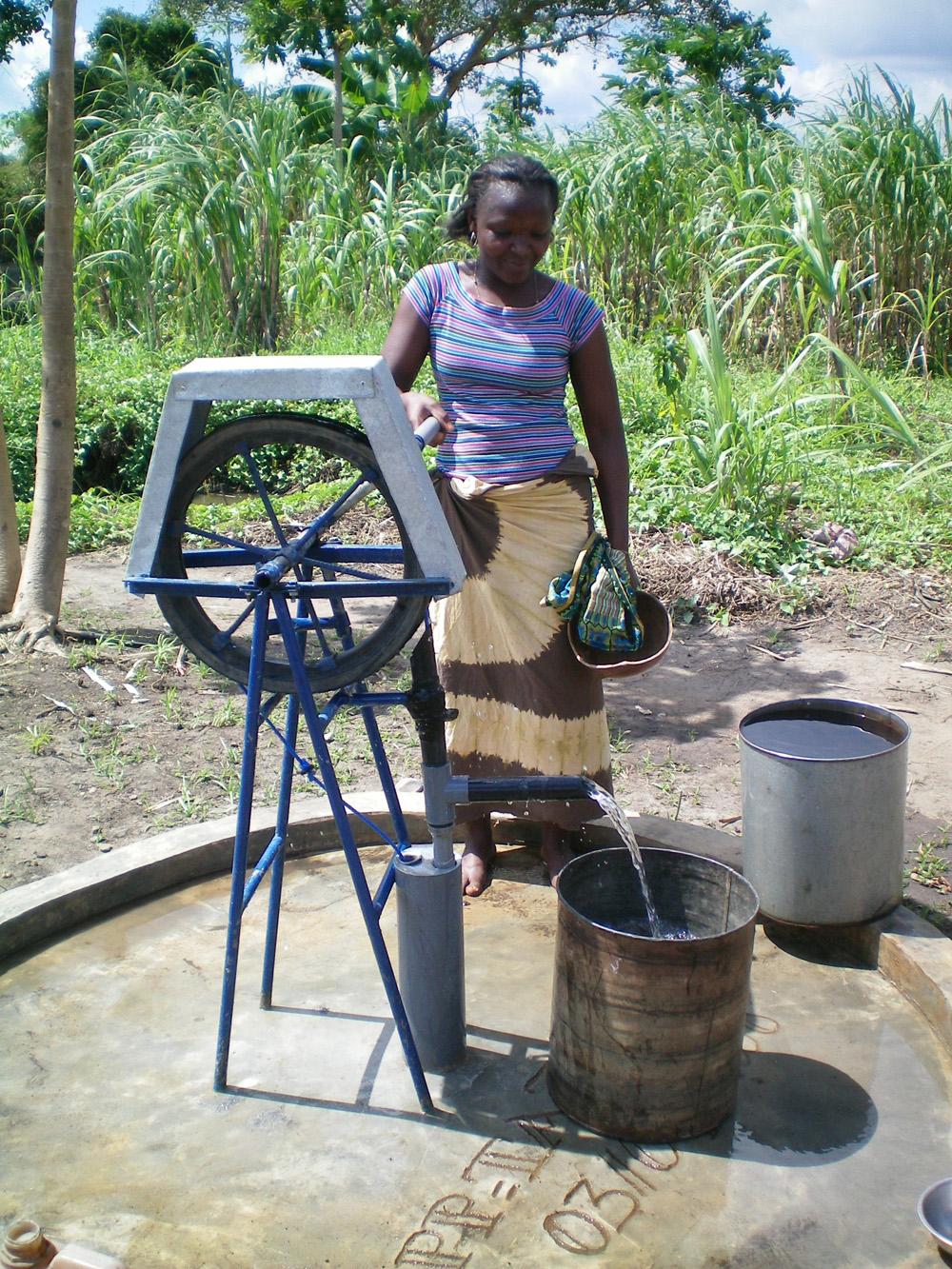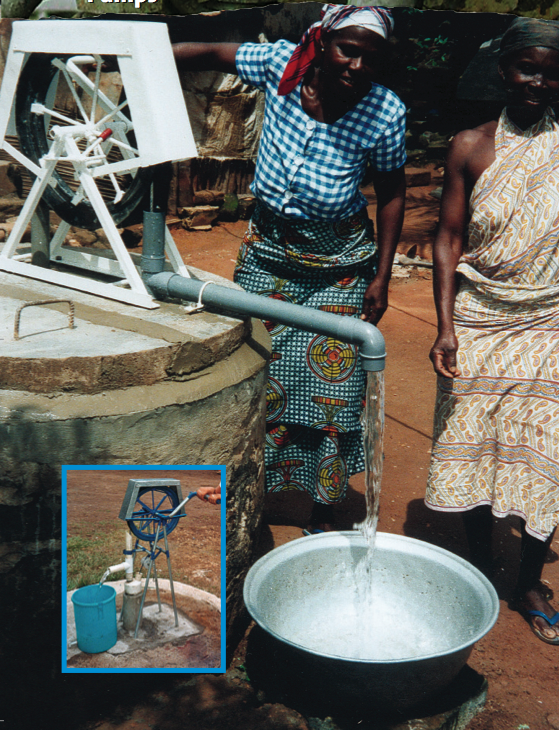Difference between revisions of "Rope pump"
(→External links) |
(→Experiences in different countries) |
||
| Line 55: | Line 55: | ||
so the pump parts wear out too fast, or parts break.</li> | so the pump parts wear out too fast, or parts break.</li> | ||
<li>With different depths, different sizes of pump pipes are needed, otherwise the pumping becomes to heavy. See manuals on websites | <li>With different depths, different sizes of pump pipes are needed, otherwise the pumping becomes to heavy. See manuals on websites | ||
| − | of Practica Foundation and Connect International.</li> | + | of [http://www.practicafoundation.nl Practica Foundation] and Connect International.</li> |
<li>The pump needs a “blocking system” on the handle to avoid return of the handle, which can be dangerous for children.</li> | <li>The pump needs a “blocking system” on the handle to avoid return of the handle, which can be dangerous for children.</li> | ||
<li>Compared to piston pumps the rope pumps splashes more. </li> | <li>Compared to piston pumps the rope pumps splashes more. </li> | ||
Revision as of 10:17, 25 August 2008
A rope pump is a kind of pump used in developing areas to raise water from wells or boreholes. Rope pumps consist of a PVC pipe, and a rope with washers attached to it. The water is held in between the washers in the pipe, and is pulled to the surface. Rope pumps are very simple, and can be easily repaired. They are used for domestic water supply, irrigation and cattle watering.
For wells down to 35 m, rope pumps are often five times cheaper and more sustainable than piston pumps. Evaluations show that rope pumps on communal wells are being maintained by the users, if introduced properly. 90% of rope pumps remain operational, even after many years.
Because of its low cost, the pump is also popular for domestic use. A survey among 5,025 rural families in Nicaragua indicates that a rope pump increases income, even if used for domestic purposes only. Families with a pump earn US$ 220 per year more than families without a pump. In Nicaragua the pumps are now being produced commercially by 20 workshops. Different models of Rope pumps were introduced in Africa. This introduction has not always been successful: in some projects over 80% of the pumps do NOT work! However, with the "right" models and the "right" user training, up to 90% remain in operation in Africa, as the Victory model in Ghana and the Elephant model in Zimbabwe have proved.
Experiences in different countries
In 2008, rope pumps are used in over 30 countries. Below the experiences in Nicaragua, Zimbabwe and Ghana are listed.
Nicaragua Some 70.000 rope pumps have been installed since 1990. The shift from imported piston pumps of 600$ to locally produced rope pumps of 70$ has doubled rural water supply in ten years, much faster than countries that apply piston pumps. Users do the maintenance and over 95% of the pumps remain in operation. The rope pump has been adopted as the standard water pump by the government.
Zimbabwe A rope pump model called the Elephant pump was introduced by the organisation Pump aid in 1990. Now some 3,000 pumps serve 950,000 people and some 95% of the pumps are working. Many more pumps are planned to be installed before 2015 and if this can be realized, this will reach 3 million more people.
Ghana The first experiences with rope pumps in Ghana were discouraging. In a World Bank funded project, 80% did not function after one year because of lack of user involvement and production errors. After improvements some 1600 pumps were installed.
Malawi, Blantyre trials Several rope pumps were introduced in order to provide a better alternative for the Afridev Community handpump, which is the standard handpump in Malawi. The Afridev is not popular due to many breakdowns and not available spare parts, especially in the more remote areas. However, the rope pumps also broke down many times, sometimes several times per month, due to the high number of users and was therefor not considered by the users as a good alternative for a community pump, although repairs were possible. Another disadvantage mentionned was that children found it difficult to pump and sometimes got hurt when the handle security break system was not functioning (in that case the handle turns back with a high speed due to the weight of the water in the riser pipe). The communities now prefer a more reliable handpump than the Afridev, with less need for spares.
| Advantages | Disadvantages |
|---|---|
|
|
Capacity
40 litres / min from 10 meters depth.
Costs
- US$ 30-150 depending on model and cost of materials and labour.
Applying conditions
- Numbers: 70,000 in Nicaragua, 20,000 in Mexico, Honduras, Guatemala, El Salvador, Ethiopia, Ghana, Senegal, Tanzania, Zambia, Mozambique, Zimbabwe, Cambodia, India, Vietnam, and others.
- Range of depth: 1-35 meter (60 m with two cranks).
- Application Communal wells, houshold, irrigation, cattle watering.
- Suggested use The pump can be used by single families, or up to 20 families (100 people).
- Models Rope pump models exist that are driven by hand, small motors, windmills, bicycle, and horses. They can be placed on hand dug wells or boreholes.
- Cost of introduction: US$ 10,000-30,000 per project, including 20 pumps, engineering and hands-on training.
- Rural water programme: US$ 150,000-200,000 per project, including 1,000 pumps, start up of production facility and hands-on training.
Rope pump construction manual
PRACTICA foundation and the Technical Training Programme of the ETC Foundation (TTP/ETC) have put together a really excellent manual on how to build rope pumps (PDF, 2.5 Mbyte). It is an 86 page long document with detailed instructions.
Movies
- Rope pumps around the world (Connect International, Netherlands, 2008)
- Small scale irrigation with a rope pump, Zambia (Connect International, Netherlands, 2008)
- Hand drilled borehole and rope pump in Tanzania (Connect International, Netherlands, 2008)
- Windmill powered rope pump in Nicaragua (S.J. Batchelor, 1999)
- Rope Pump animation (Resource Development International Cambodia, RDI)
- Water quality and rope pumps in Cambodia part 1 (RDI-Cambodia)
- Water quality and rope pumps in Cambodia part 2 (RDI-Cambodia)
External links
- Evaluations www.irc.nl
- Africa www.pumpaid.org
- General info www.ropepump.com
- Construction manual Practica Foundation
- Construction manual Connect International
- How to build www.ropepumps.org
- Cambodia http://www.ideas-at-work.org/IdeasRopePump.html
- Rope Pump info at Demotech




